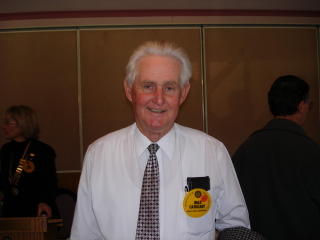
By Special Safari Correspondents
John Flower and
Paul Ying.
Over the last month on the road the Safari Team has been fine-tuning the display and the placement of the Winnebago.
There has been some excellent coverage in local media including television coverage in Toowoomba and the response from Rotary Clubs along the way has been very enthusiastic.
The best displays have been where we have been able to park the Winnebago right on a “main street” in front of a newsagent, chemist or supermarket. People walk right alongside the display and can be easily approached by the team.
In thirty-two days on the road the Safari team have put up and dismantled the display 82 times, have attended and spoken at 17 Rotary meetings (breakfasts, lunches and dinners) and five forums.
They have heard the display’s video presentation so many times they now know it off by heart and occasionally turn the sound down so they can say the words!!
The Safari volunteers so far have been Gerry Davies (RC of Waratah). John and Margaret Stuckey (RC of Warrnambool) Howard Fleming (RC of West Pennant Hills), Jim Nolan (RC of Loganholme) and Ashley John from the RC of South Brisbane.
The next team changeover happens this week in Brisbane when a new group comes on board.
The second page of this update is the key document to pass on to all people and clubs making arrangements for the display.
A number of clubs which the Safari has already visited have sent in evaluation forms and the points raised in them have been given consideration by the Safari team in consultation with the Safari committee in Sydney. The display has been revised and altered a few times trying to get the right presentation and will probably change again as it travels.
The first month has been spent setting up the systems and establishing a routine. It now takes about fifteen minutes to set up the display and the team have it down to a fine art!
The next month, travelling north up the coast of Queensland, will be the implementation phase with some fine-tuning of the display.
The office on board the Winnebago operates well and can send and receive e-mails and upload photos daily to the website.
The Safari is travelling well and looking forward to coming to your area! Are you ready for us??
PLANNING FOR THE SAFARI
The purpose of the visit of the Safari is:
1. To create awareness of the importance of mental health for all
2. To promote knowledge among Rotary clubs of the ARHRF activities
The following points must be considered when arranging for the Safari:
Pick a site for the Winnebago with high pedestrian traffic in the same way real estate people think position, position, position! Car parks opposite or just off the main street are not as good as the main street. Pedestrian malls are very good places. Outside supermarkets, cafes and newsagents are always good locations. Try and avoid areas where there are columns or planter boxes on the edge of the pavement. Parks across the road from shops or a place outside a Town Hall or Civic Centre are no good unless there is guaranteed pedestrian traffic.
Try and locate the Winnebago near a power outlet. The Winnebago does have a generator on board but it is much better if mains power can be arranged from a shop or office at the site. The van carries a very long extension cord and the power is only for computers and lights.
Invite local mental health support groups or government health workers to participate in the display. This means there is a local contact for any potential customers who visit the display.
Plan for an activity to attract people to the display. On Saturday mornings arrange for a free bbq alongside the display.
Sundays – use Harvey Norman stores or places where people will be
The display can start as early as 8 am but should finish by 4.30 / 5 pm
Make contact with the press, radio and TV several weeks before hand to gain maximum publicity for the Safari. Be specific about where and when the Winnebago will be parked
Make sure you have sufficient posters to be placed in shop windows, health offices and businesses in the area.
Plan a forum to coincide with the visit of the Safari. The forum should be held the night before and should promote the place where the Winnebago will be on the next day.
If you have a member in your club who is a good 'spruiker' or salesman, ask them along to help attract people to the display
Where possible members of the Rotary club should make an effort to visit the van so they can talk about the Safari after it has moved on.
Note: - John Flower is Safari Manager












